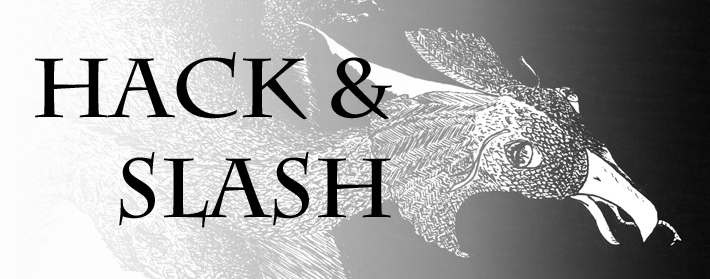Brendon of OSR search asked me to key this location from Matt Finch's Demonspore module. (Print) (.pdf)
Original Text reproduced under "Fair Use".
5. The Lake PortcullisHow I would code such a room.
BEGIN boxed text
A massive portcullis of wooden beams, bolted together with iron, bars the way across the tunnel and river. The unpleasant smell of rotten fish is heavy in the air.
END boxed text
Monsters
• Toad-Man Sentries (2): HD 2+1; HP 11, 5; AC 6[13]; Atk 1 spear (1d8); Move 9 (Swim 12); Save 16; AL C; CL/XP 2/30; Special: None.
Description
Two toad-man sentries guard this portcullis. Because the dam beyond (AREA 4) is also protected by a locked gate and portcullis, guards at this portcullis are almost never particularly alert. If a party of adventurers calls out from the gate at the dam, or lingers very long there making noise or carrying a light, the guards will raise the portcullis and go to find out who seeks entrance into the Halls from the river. Obviously, this is a foolish way of manning the defenses since it leaves the portcullis open. However, it has been so long since the Halls faced any serious attack from the river entrance that the toad-men are not cautious at this entrance. Just inside the portcullis there are five reeking wooden buckets, half-filled with what appear to be fish guts. These are used to placate the toad-hydra beneath the bridge at AREA 9. If the party peacefully buys entrance into the Halls, the sentries will hand them a bucket of fish guts, and explain, “For crossing the bridge.”
The central part of the portcullis, which descends into the river, has longer bars than the rest of the gate, descending into the river itself. However, the bars do not actually extend all the way down to the riverbed, and if the party is entering (or leaving) the Halls under the river, it would be easy to squeeze underneath.
Treasure: One toad-man carries a pouch containing 10gp and a small crystal worth 50gp. The second toad-man carries 22gp and a potion of healing.
Lake Portcullis 5) | Portcullis→wooden→blocks tunnel & river→can pass under portcullis
Beyond Portcullis→buckets→wooden→reeking→fish guts
|→If party noticed (light, noise) 2 Toad-Man Sentries approach
(AC 6[13], HD 2+1; HP 11, 5; spear 1-8; Save 16; XP30)
|→Pouch→leather→1) crystal (50 gp), 10 gp; 2) Potion (healing), 22 gp;
Toad-Man Sentries raise portcullis to approach party.
|→ Fight→Defend in tunnel
|→ Parley→Purchase Passage→Fish gut bucket→"For Crossing Bridge"Why do things this way? The physical structure of the room is first. The relevant triggers for action are bolded much like the immediately visible items because they are the "immediately important actions". Monsters are underlined with stats in italics, allowing me to ignore them when scanning the description and find them quickly when combat starts. (You can test this. Look away and think "I'm going to look for the monster"; or "monster stats"; or "what the players can see from the entrance". Then glance back and see how long it takes you to find it.)
The various options when interacting with the sentries are outlined here. It is separated for ease of location. I just wrote what was in the original key, though in my games, I would also add a personality word and some 'Combat Commentary' in the left hand margin.
I find that the quick outline gives me the information I need allowing me to facilitate a game without having to stop the game to read.
Have a separate section of the module for 'exposition' before each dungeon section is where a broad overview can be presented. This beginning narrative explication would give the person running the game, the information they need to parse any more complicated situations. Visual aids such as artwork and descriptive useful maps (with light sources, sound ranges, verticality) also help.
The reason I prefer the above to the ultra-simple Teagol Manor style, because it makes it more clear what is in the room at a glance, and provides slightly more information making my responses more varied and creative.

